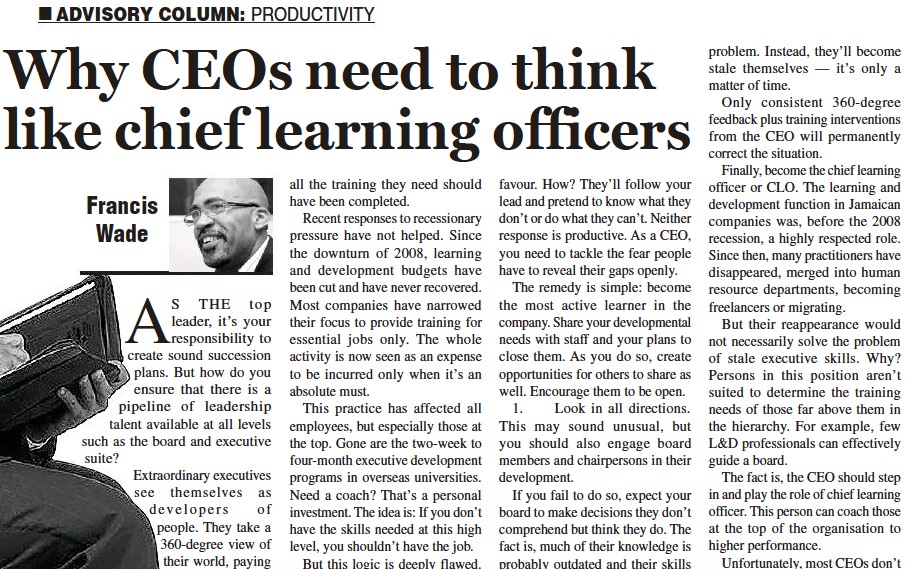As the top leader, it’s your responsibility to create sound succession plans. But how do you ensure that there is a pipeline of leadership talent available at all levels, such as the board and executive suite?
Extraordinary executives see themselves as developers of people. They take a 360-degree view of their world, paying attention to every scrap of expertise they can rely on to get the job done.
This perspective is an unusual one to adopt. After all, the default assumption is that by the time someone reaches the top of an organization, they should be fully ready for the role. In other words, all the training they need should have been completed.
Recent responses to recessionary pressure have not helped. Since the downturn of 2008, learning and development budgets have been cut, and have never recovered. Most companies have narrowed their focus to provide training for essential jobs only. The whole activity is now seen as an expense to be incurred only when it’s an absolute must.
This practice has affected all employees, but especially those at the top. Gone are the two-week to four-month executive development programs in overseas universities. Need a coach? That’s a personal investment. The idea is: “If you don’t have the skills needed at this high level, you shouldn’t have the job.”
But this logic is deeply flawed. Things are changing so quickly in our world, fueled by new technology, that no-one should feel secure in what they know today. Instead, their only lasting weapon is their capacity or ability to grow. How can you produce this transformation as your company’s leader?
- Make it safe to have gaps
If you’re the kind of leader who must demonstrate superior knowledge and skill at all times, you’ll be in trouble. Why? Your competitive nature got you the top leadership job, but now it’s preventing you from helping others.
For example, your peers may believe that you don’t have gaps (or don’t see them.) They’ll return the favor. How? They’ll follow your lead and pretend to know what they don’t, or do what they can’t. Neither response is productive. As a CEO, you need to tackle the fear people have to reveal their gaps openly.
The remedy is simple: become the most active learner in the company. Share your developmental needs with staff and your plans to close them. As you do so, create opportunities for others to share as well. Encourage them to be open.
- Look in All Directions
This may sound unusual, but you should also engage board members and chairpersons in their development.
If you fail to do so, expect your board to make decisions they don’t comprehend, but think they do. The fact is, much of their knowledge is probably outdated and their skills are stale. Yet, they must decide between competing proposals in board meetings the best they can.
The same, of course, applies to the occupants of the C-Suite. Realize that most companies under-invest in training at this level. Somehow, the thinking goes, smart people should train, coach and develop themselves. Apparently, they have all the time in the world to do so.
This folly leads CEOs to ignore the developmental needs of others immediately around them. When things fall apart, some seek knee-jerk solutions: firing colleagues and hiring replacements immediately upon failure. This short-term thinking mistakenly assumes that new staff members will fix the problem. Instead, they’ll become stale themselves – it’s only a matter of time.
Only consistent 360-degree feedback plus training interventions from the CEO will permanently correct the situation.
3. Become the Chief Learning Officer
The Learning and Development function in Jamaican companies was, before the 2008 recession, a highly respected role. Since then, many practitioners have disappeared, merged into Human Resource departments, becoming freelancers or migrating.
But their reappearance would not necessarily solve the problem of stale executive skills. Why? Persons in this position aren’t suited to determine the training needs of those far above them in the hierarchy. For example, few L&D Professionals can effectively guide a board.
The fact is, the CEO should step in and play the role of Chief Learning Officer. This person can coach those at the top of the organization to higher performance.
Unfortunately, most CEOs don’t have skills in this area. Yet, they must have developmental conversations with C-Suiters and also Board Members. No-one else is equipped. Failing to act is the same as allowing the company to languish.
As such, CEO’s should think like CLOs to help organizations succeed. In these tumultuous times, the need is greater than ever before.

